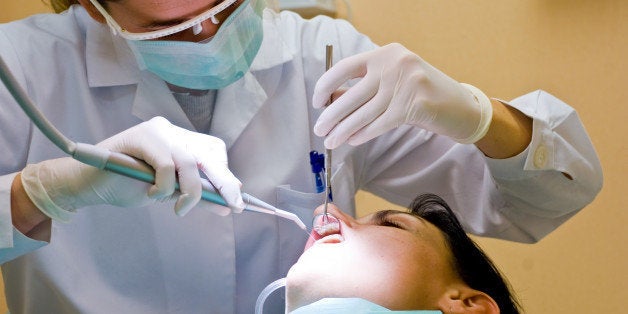
Kyle Willis had a toothache. What he didn't have was a job -- or health and dental insurance. Willis, who lived in Cincinnati, first visited a nearby dentist, where he was told one of his wisdom teeth had to be pulled. However, as an unemployed, single father, he had no way to pay for the procedure and decided to endure the pain. Just a few weeks later, Willis developed a headache and the side of his face swelled like a balloon. He went to the Emergency Room, where he was prescribed painkillers, which cost $3, and antibiotics, which cost $27. Unable to afford both, he bought only the painkillers. While he was able to stop the pain over the next few days, the infection spread to his brain and caused it to swell. He was rushed to the hospital, where he later died. Willis was 24.
This isn't a one-off tragedy. Like Willis, 130 million Americans -- over 40 percent of the population -- do not have dental insurance. Over the last ten years, millions of patients have been showing up with dental pain to hospital emergency departments (EDs) instead of dental practices, at the cost of billions to hospitals, in hopes of receiving quick and affordable relief. ED physicians, however, cannot do much to treat dental pain other than prescribe painkillers and antibiotics, and inform patients upon discharge to visit a dentist. However, over 70 percent of patients who visit the ED for dental-related conditions have no form of dental coverage and nearly one-fifth return to the ED with the same problem soon afterwards, signaling that a significant number of people are having trouble accessing affordable dental care. The end result can be fatal. 101 patients were found to have died due to dental-related problems in the ED in just a three-year span.
This game of life or death is largely a political battle. While 44 states offer some capacity of dental benefits to Medicaid-enrolled adults, only 28 offer coverage beyond emergency treatment, but still fall short of the standard of care needed to maintain adequate oral health. Under the Affordable Care Act, 30 states, including the District of Columbia, intend to expand Medicaid eligibility to adults at up to 138 percent of the federal poverty level. Although the ACA mandates dental coverage for individuals less than 18 years of age, adult dental coverage remains optional for insurers. However, at least 22 of those Medicaid-expansion states intend to offer dental benefits to newly eligible enrollees. 10 will offer extensive benefits, 7 will offer limited benefits, and 5 will offer emergency benefits-services provided for the relief of pain and infection under defined emergency situations-alone. Limited benefits include select diagnostic, preventative, and minor restorative procedures. This covers less than 100 of the approximately 600 procedures recognized by the American Dental Association's Code on Dental Procedures and Nomenclature. The per-person annual expenditure is capped at $1,000. Extensive benefits, in contrast, covers at least 100 of the approximately 600 procedures recognized by the American Dental Association's Code on Dental Procedures and Nomenclature. The per-person annual expenditure is capped to at least $1,000, if not more. To no surprise, states that opted out of providing dental coverage in their benefits packages cited cost as their primary determining factor.
This trend is symptomatic of a larger structural and socioeconomic issue. The use of the emergency department for dental problems serves as a marker for disparities in the quality of and access to adequate dental care and health literacy. Over 70 percent of patients who come into the ED for dental-related visits reside in low-income geographic areas. Medicaid enrollees often have trouble finding the only 20 percent of dentists who accept Medicaid. Low reimbursement rates, high rates of cancelled appointments, low compliance with treatment, and the administrative burden all contribute to the scarcity in Medicaid-accepting dentists. Additionally, access to dental care is limited not only by insurance coverage, but also an individual's discretionary income and geographical location. As a result, low-income patients are at higher risk to forgo dental care altogether, despite experiencing a greater burden of oral disease.
Although significant evidence links poor oral health to systemic diseases, particularly diabetes mellitus and cardiovascular disease, most people are uneducated about the consequences of poor oral hygiene and its role in overall health. Poor oral health literacy and compliance among families is highly evident in the case of childhood tooth decay. Although it is virtually preventable, tooth decay is the most common chronic illness among children. When ignored or untreated, it can cause severe pain, tooth loss, systemic infection, and, in some cases, death. Despite this, nearly one in four children in the U.S. have untreated tooth decay. For low-income children, it's every one in two.
The problem doesn't disappear with age either. The U.S. Centers for Disease Control and Prevention estimate that nearly 50 percent of Americans over 30 suffer from periodontitis, which destroys the gum tissue and bone that supports teeth and the jaw. In adults over 65, that number jumps to over 70 percent. In advanced cases, affecting nearly 9 percent of Americans, it can cause tooth loss, pneumonia, poor pregnancy outcomes, and chronic inflammation, increasing the risk of diabetes, cardiovascular disease, and stroke. Additional costs associated with these systemic health problems as a result of poor oral health also contributes to otherwise preventable healthcare spending. Chronic illness management costs the U.S. healthcare system nearly $300 billion annually.
Herein lies the economic incentive-in addition to improving the quality of U.S. healthcare-for hospital administrators and policymakers to design and implement health system models to alleviate disparities between access to dental care and medical care.
Local and state governments should expand dental clinics within Federally Qualified Health Centers (FQHCs), of which the Affordable Care Act allotted $11 billion in new funds, and other community health centers in low-income areas. Less than 60 percent of FQHCs offer dental services, and those that do provide significantly limited adult dental care. While only about 2 percent of the dental workforce provides care within FQHCs, the 2009 Children's Health Insurance Program Reauthorization Act (CHIPRA) stipulated that FQHCs may contract with private dentists to provide dental care to health center patients in private dental offices. Increasing the number of private dentists who contract with federally supported health centers may increase dental coverage to underserved populations and, given the increased patient pool, incentivizes dentists, particularly recent graduates, to contract with FQHCs.
Finally, establishing literacy campaigns in conjunction with the expansion of FQHC dental coverage, either through coordination with federal insurance programs, dental care companies, or media partnerships, will be essential in improving oral health education and utilization of dental services among newly eligible Medicaid beneficiaries, because no one deserves to lose their life to a toothache.
